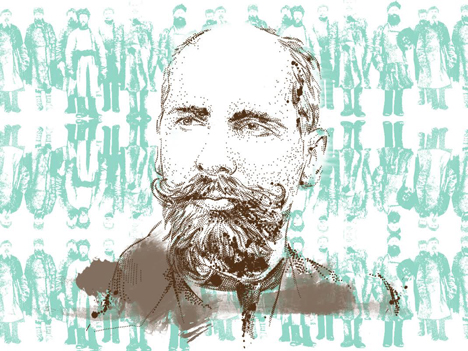

Drawing by Natalia Mikhaylenko
Pyotr Stolypin (1862-1911), a reformist who served as prime minister in tsarist Russia, was a true European. He was born in Dresden, Germany, lived in Lithuania and holidayed in Switzerland.
He was a tall, handsome man, very hardworking; he slept just four hours a day. Stolypin was popular with women but was a faithful husband, and father to five daughters and a son.
At the time of the 1905 revolution, he was the governor of Saratov Region. Stolypin inspected rebellious areas unarmed and without bodyguards. During one of these trips, somebody dropped a bomb under his feet. There were casualties, but Stolypin survived.
Two photographs from that time remain: One shows mutinous peasants threatening the governor with fists and sticks; the other, the very same peasants, on their knees, asking his forgiveness.
The tsar appointed him first interior minister and then prime minister. He was the only man in the then government who could cope with running the country, and the tsar was a weak man.
Officials had only their own interests at heart, while politicians in the parliament spent their time in heated debates as to what needed to be done but were unable to actually do anything.
In the meantime, the situation in the country was extremely difficult. Russia had just suffered a humiliating defeat in the war with Japan. One political crisis came after another. There were arson attacks and rioting in the cities. Various terrorist groups were engaged in a so-called dynamite war, carrying out bomb attacks targeting senior officials.
Stolypin's country house was nearly destroyed in one such attack. His daughters were wounded, and some 30 people from among the guests and the servants were killed.
The explosion was so big that the windows in a house across the river from Stolypin's were smashed. When the tsar offered Stolypin money for his daughters' treatment, he replied, "Your majesty, my children's blood is not for sale."
Stolypin began his work as prime minister with introducing court-martials and announcing an agrarian reform. The latter meant that he gave land to the peasants.
That was the promise that Lenin gave to the people in 1917, except that Lenin never kept it, whereas Stolypin did. He realized that if peasants were turned into private owners, it would reduce the risk of a revolution.
Stolypin relied on economic liberalism and a strong power. Many years later Pinochet did a similar thing in Chile. Having grasped the essence of Stolypin's reforms, German Kaiser Wilhelm II said that it was necessary to start a war with Russia as soon as possible; otherwise it would be impossible to defeat it.
Stolypin's reform was supposed to give peasants what the end of serfdom in 1861 had failed to give. Back then peasants were liberated from serfdom but were not given any land.
They became free but they did not become landowners. Stolypin wanted to turn Russia from a country of communes into a country of farmers.
Like the United States, the Baltic countries, and almost all Western countries, the farmer was the basis of the country's agriculture. One of Stolypin's assistants wrote at the time that "Russia's tragedy consists in that the issue of land-tenure regulations was not addressed right after the Liberation…
Western Europe has managed to (and will continue to) avoid bolshevism precisely because land relations and regulations for a French, German, English, or an Italian farmer have long been settled."
But the time was lost. The public was vehemently opposed to the reform. Leo Tolstoy was particularly indignant. He wrote to Stolypin directly and said, "Stop your horrible activity! Enough of looking up to Europe, it is high time Russia knew its own mind!"
That was the argument that Tolstoy often had with Dostoyevsky, who was in favor of private ownership of land. Dostoyevsky wrote: "If you want to transform humanity for the better, to turn almost beasts into humans, give them land and you will reach your goal."
Transformation for the better involved a lot of blood. More than 1,000 terrorists were executed by Stolypin's court-martials. In one of his interviews, Stolypin said: "I have grabbed the revolution by the neck and I will strangle it, if I myself remain alive."
The reform was stalling. The landed gentry were worried for their estates. Socialists realized that if the reform succeeded, they would lose the support of the people. And the people themselves were not particularly eager to become landowners.
New owners had to be transported to their land by force in what became known as Stolypin cars. Yet the reform did manage to produce some results. Before the First World War, Russia was a prosperous country, judging by all economic indicators.
However, Stolypin did not live to see it. Everybody knew that he would be assassinated, including he himself and the security services. The attack took place at the theatre in Kiev, at a performance of Rimsky-Korsakov's opera "The Tale of Tsar Saltan."
After the famous "Flight of the Bumblebee," a young man approached Stolypin and shot him twice. Stolypin unbuttoned his jacket soaked in blood, sank into his chair and said, "I am happy to die for the tsar!" Interestingly, the tsar was present at the opera, but the attacker targeted Stolypin rather than him, since Stolypin was more dangerous.
The assassin, whose name was Dmitry Bogrov, was a revolutionary and at the same time, an undercover agent for the security services. He was soon tried and hanged.
It is still not quite clear who was behind the assassination. But one thing is clear: Stolypin was hated by everybody — the authorities and the people alike, the whole of the country whom he desperately tried to drag into the 20th century.
All rights reserved by Rossiyskaya Gazeta.
Subscribe
to our newsletter!
Get the week's best stories straight to your inbox